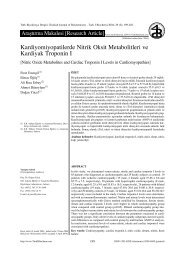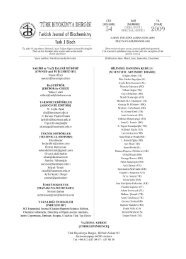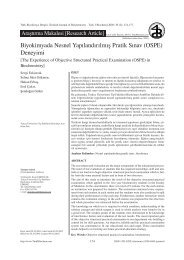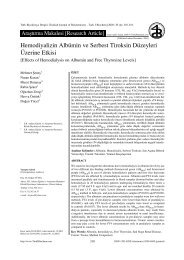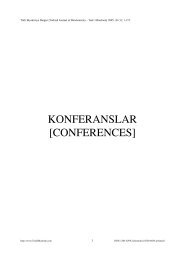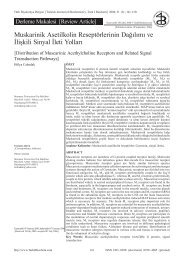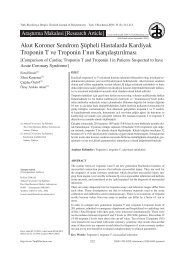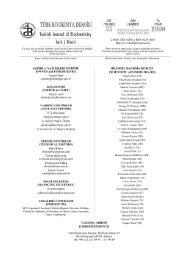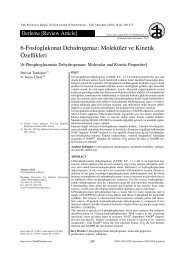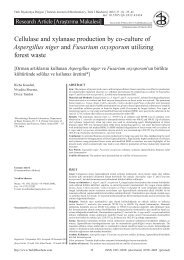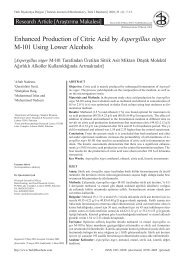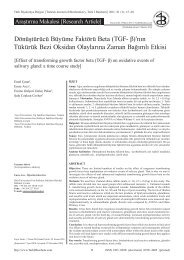24. Ulusal Biyokimya Kongresi - Türk Biyokimya Dergisi
24. Ulusal Biyokimya Kongresi - Türk Biyokimya Dergisi
24. Ulusal Biyokimya Kongresi - Türk Biyokimya Dergisi
- No tags were found...
You also want an ePaper? Increase the reach of your titles
YUMPU automatically turns print PDFs into web optimized ePapers that Google loves.
XXIV. ULUSAL B‹YOK‹MYA KONGRES‹<br />
25 - 28 Eylül 2012<br />
Dedeman Otel - Konya<br />
<strong>24.</strong> <strong>Ulusal</strong> <strong>Biyokimya</strong> <strong>Kongresi</strong>, Konya [24 th National Biochemistry Congress, Konya / TURKEY]<br />
İÇİNDEKİLER<br />
P042 - FARKLI OGTT İSTEMLERİNİN DEĞERLENDİRİLMESİ<br />
1<br />
Gülsen YILMAZ, 1 Vildan FİDANCI, 1 Aytün Ş. KILINÇ,<br />
1<br />
Hatice SÜRER, 1 Elmas ÖĞÜŞ, 1 Doğan YÜCEL<br />
1<br />
S.B. Ankara Eğitim ve Araştırma Hastanesi,, Tıbbi <strong>Biyokimya</strong> Bölümü, Ankara<br />
P042 - EVALUATION OF DIFFERENT OGTT REQUESTS<br />
1<br />
Gülsen YILMAZ, 1 Vildan FİDANCI, 1 Aytün Ş. KILINÇ,<br />
1<br />
Hatice SÜRER, 1 Elmas ÖĞÜŞ, 1 Doğan YÜCEL<br />
1<br />
Ankara<br />
CONTENTS<br />
Giriş: OGTT (Oral Glukoz Tolerans Testi), uygulama zamanı ve yöntemi<br />
konusunda farklı görüşler bulunan bir testtir. 1997’de ADA ve daha sonra WHO,<br />
1979’daki NDDG (National Diabetes Data Group) yayınını temel alan, diyabetin<br />
yeni sınıflandırma ve tanı kriterlerini yayınladılar. OGTT, önceleri DM tanısında<br />
altın standart olarak tanımlanırken ADA tarafından önerilmedi (2012’de ADA<br />
OGTT’yi DM taraması için uygun bir test olarak önermektedir) fakat WHO<br />
tarafından önerilmeye devam etti. Ayrıca WHO OGTT uygulanırken, National<br />
Diabetes Data Group (NDDG) tarafından 1979’da yayımlanan 0, 30 60, 90 ve<br />
120. dakikaları içeren beş örnekli OGTT yerine 0 ve 120. dakikaları içeren iki<br />
örnekli OGTT’yi önermiştir. Gereç ve Yöntem: Bu çalışmanın amacı sonuçların<br />
yorumundaki farklı tavsiyelere göre örnek sayısı kullanımını araştırmaktır. Veri<br />
tabanımızdaki 2012 hastanın verileri değerlendirildi ve 3 gruba ayrıldı: iki, üç ve<br />
beş örnek içeren 75 g OGTT istemleri. Sonuçlar ADA, WHO ve NDDG kriterlerine<br />
göre değerlendirildi. Sonuçlar: Beş örnekli OGTT istemlerinin yüzdesi % 69.6; üç<br />
örnekli olanların 14.9 % ve iki örnekli olanların % 15.5 idi. NDDG’nin 0, 30,<br />
60, 90 ve 120. dakikada örnek toplama önerisi, % 69.6 ile en çok tercih edilendi.<br />
WHO’nun 0 ve 120. dakikada örnek toplama önerisi, istemlerin % 15.5’inde takip<br />
edildi. OGTT 2. saati normal bulunan hastalarda 30, 60 ve 90. dak. örneklerinde<br />
200 mg/dL üzerinde sonuç varlığı değerlendirildi ve 30, 60 ve 90 dak. örnekleri için<br />
sırasıyla % 4.6, % 8.4 ve %1.8 olarak bulundu. Tartışma: Çalışmamızın sonuçları,<br />
OGTT uygulamasında standardizasyonuna gerek olduğunu göstermektedir.<br />
Verilerimiz farklı öneriler arasında daha fazla işbirliği ihtiyacını vurgulamaktadır.<br />
Introduction: Oral Glucose Tolerans Test (OGTT) is a test which have different<br />
approaches in its application time and method. In 1997, an International Expert<br />
Committee of ADA published new classification and diagnostic criteria of<br />
diabetes, which were based on the 1979 publication of the National Diabetes<br />
Data Group and subsequent WHO study group. OGTT, once the gold standard for<br />
diagnosing diabetes mellitus, was not recommended by ADA (In 2012, OGTT is<br />
recommended as an appropriate test for screening DM by ADA), but continued<br />
to be recommended by the World Health Organization (WHO). Also, WHO<br />
published new indications for performing OGTT that recommended to collect<br />
two samples at baseline and at 120 min, rather than five samples at baseline,<br />
30, 60, 90 and 120 min, as published previously by the National Diabetes<br />
Data Group (NDDG) in 1979. Material and Method: This study was designed<br />
to investigate the number of blood samples for the interpretation of the results<br />
according to different recommendations. We examined a database of 2012<br />
patients and distributed them into three categories: 75 g OGTT requests with two<br />
samples, three samples and five samples. And results were evaluated according<br />
to ADA, WHO and NDDG. Results: The percent of OGTT requests were 69.6 %<br />
for five samples; 14.9 % for three samples and 15.5 % for two samples. NDDG<br />
indications to collect samples at baseline and at 30, 60, 90, 120 min that was<br />
the most preferred OGTT type, were followed by 69.6 % of the requests. WHO<br />
indications to collect samples at baseline and at 120 min were followed by 15.5<br />
% of the requests. The presence of results more than 200 mg/dL at 30, 60 and 90<br />
min. samples were evaluated in patients with normal 2 h. OGTT and found as<br />
4.6%, 8.4% and %1.8, respectively. Discussion: Our results shows the need for the<br />
standardisation of the OGTT application methods. The data in our study highlight<br />
the need for greater collaboration between these different recommendations.<br />
Turk J Biochem, 2012; 37 (S1)<br />
http://www.TurkJBiochem.com



